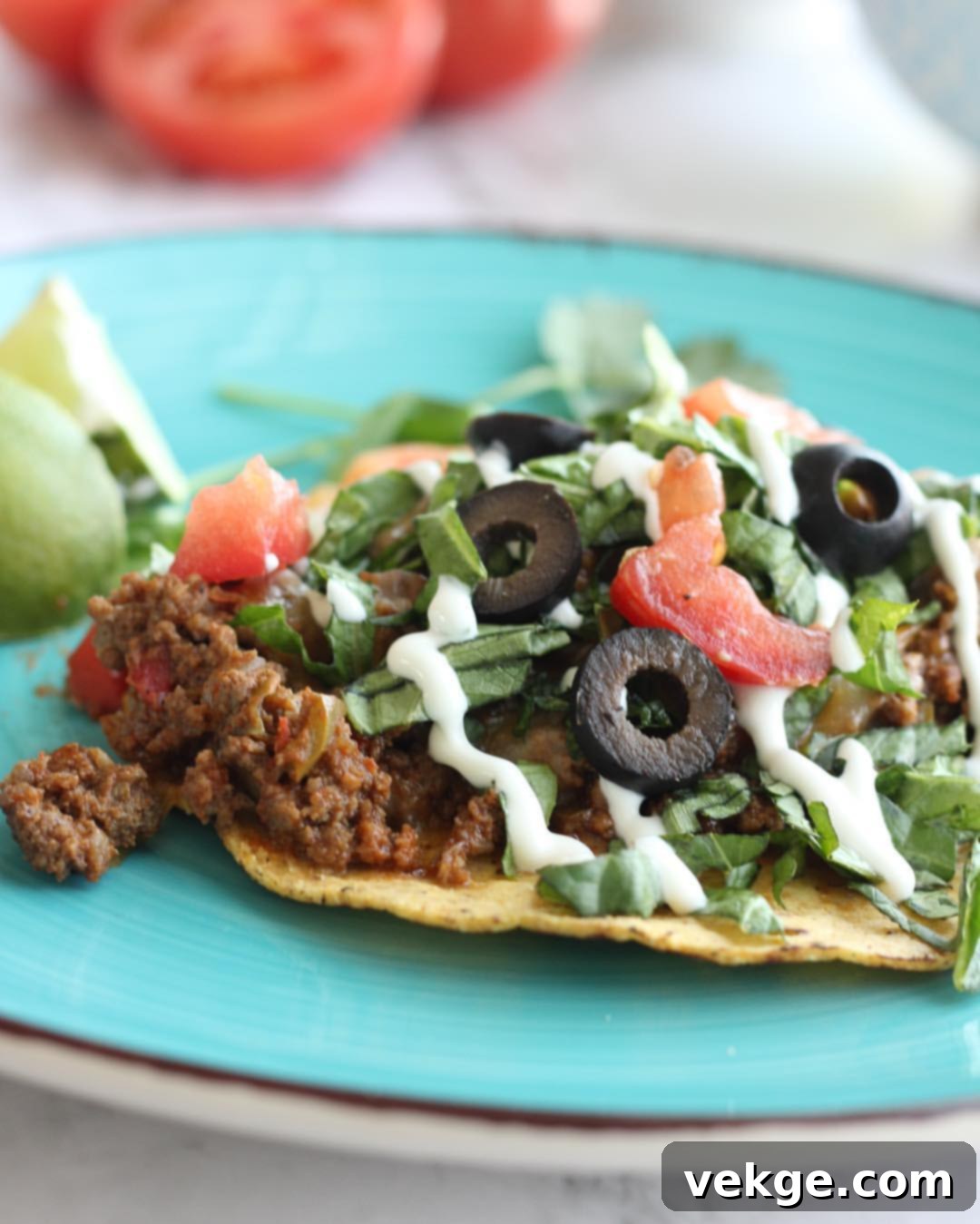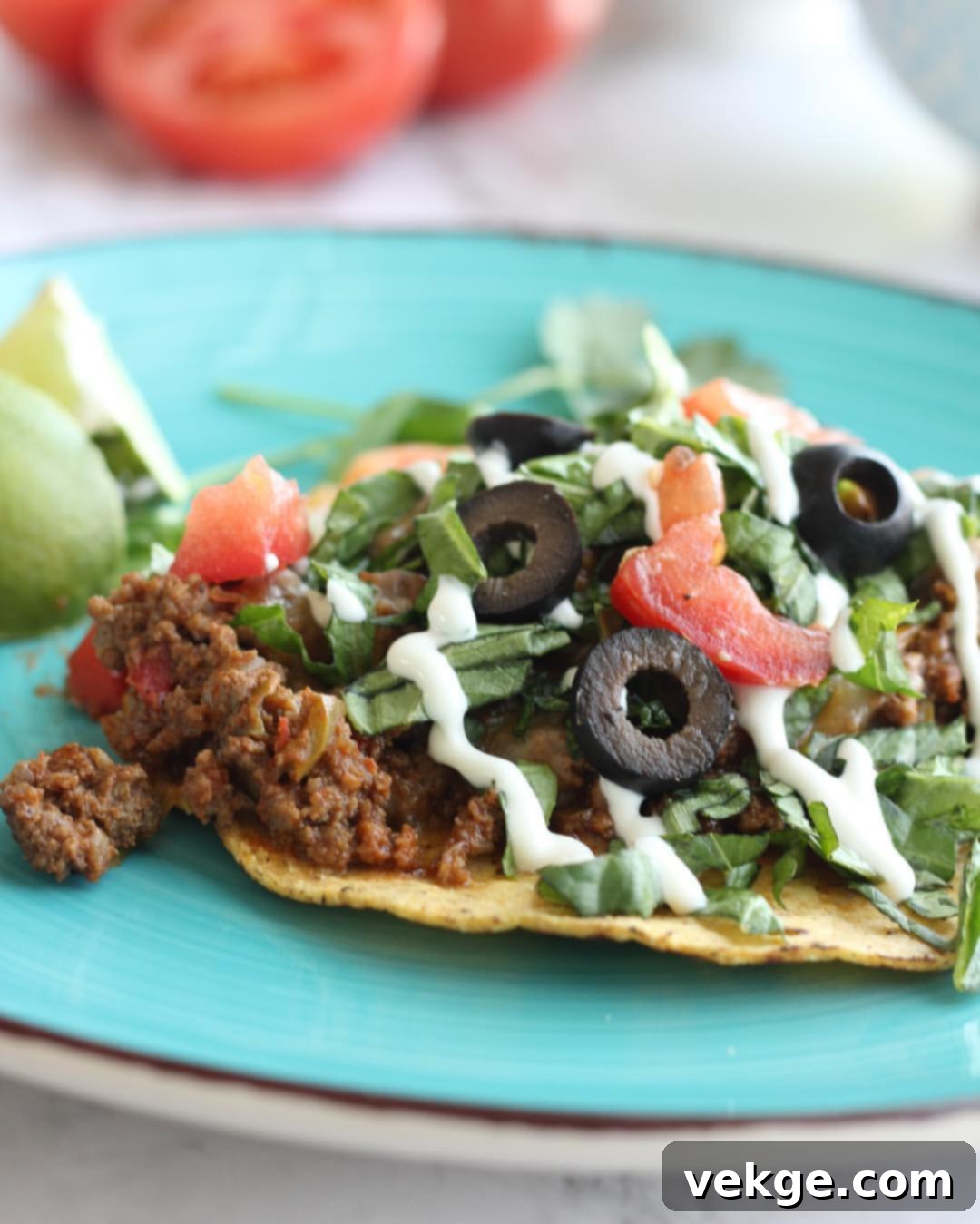The Ultimate Versatile Ground Beef Taco Filling Recipe
There are some recipes that stand the test of time, becoming enduring favorites in our kitchens. This ground beef taco filling is precisely one of them. A decade ago, I stumbled upon this gem from none other than Martha Stewart, and it has since become my go-to for everything from classic tacos to crispy tostadas, and even hearty burrito bowls. What makes this recipe truly special isn’t just its incredible flavor, but its sheer simplicity and versatility. It’s the kind of dish that consistently delivers, making busy weeknights feel like a culinary triumph.
Over the years, I’ve perfected a few nuances to this original, ensuring every bite is packed with savory goodness and just the right amount of spice. While I once shared a quick demo from my stories – a video that, let’s be honest, wasn’t cinema-quality – the star of the show has always been the filling itself. It’s robust, deeply flavored, and utterly delicious. Prepare to elevate your taco night to an entirely new level with this foolproof recipe.

For a visual glimpse into the process, you can view the original Instagram post by Amber (@amberskitchen) here.

Why This Taco Filling Is a Game-Changer for Weeknight Dinners
Forget those bland, store-bought taco seasoning packets. This homemade ground beef taco filling offers a depth of flavor that’s incomparable, turning an ordinary meal into something truly extraordinary. It’s more than just ground meat; it’s a symphony of fresh vegetables and aromatic spices that meld together beautifully. The combination of bell peppers, onions, and garlic provides a sweet and pungent base, while chili powder and cumin infuse the meat with that quintessential Tex-Mex warmth. It’s incredibly adaptable, forming the perfect foundation for a myriad of dishes, making it a staple in any kitchen.
One of the biggest advantages of this recipe is its efficiency. With a prep time of just 10 minutes and a cook time of 15 minutes, you can have a flavorful and satisfying meal on the table in under half an hour. This makes it an ideal choice for busy weeknights when you want something homemade but don’t have hours to spend in the kitchen. It’s also a fantastic way to introduce fresh vegetables into your family’s diet, subtly incorporated into a dish everyone already loves. Its make-ahead potential further solidifies its place as a weeknight hero, allowing you to enjoy delicious, home-cooked flavors with minimal effort on the busiest of evenings.
Essential Ingredients for the Best Homemade Taco Meat
Each ingredient in this recipe plays a crucial role in developing its rich, balanced flavor profile. Let’s delve into why these specific components are key to creating the ultimate taco experience, ensuring your homemade taco meat is bursting with flavor:
- Ground Beef (1 pound): The foundation of our filling. Opt for a lean-to-medium ground beef (80/20 or 85/15) for the best balance of flavor and texture. If you prefer a leaner cut, simply ensure you add enough water or broth to maintain moisture and prevent the filling from becoming dry. Properly browning the beef is essential for developing deep, savory notes and a robust base for your filling.
- Onion (1 medium, diced): Onions caramelize as they cook, adding a natural sweetness and aromatic depth that complements the savory beef. Dicing them finely ensures they soften evenly and meld seamlessly into the filling, releasing their flavor without overpowering the dish.
- Green Bell Pepper (1, diced): Adds a fresh, slightly peppery flavor and a vibrant color. Bell peppers also contribute essential nutrients and a satisfying texture. When diced, they integrate well into the ground beef mixture, adding a subtle crispness.
- Red Bell Pepper (1, diced): Similar to green bell pepper but with a distinctly sweeter profile. The combination of both green and red bell peppers creates a more complex flavor profile and a visually appealing dish, adding natural sweetness and a mild crunch.
- Garlic (1 clove, minced): The aromatic backbone of countless delicious recipes. Freshly minced garlic provides an indispensable pungent and savory note that truly elevates the entire dish. Add it towards the end of cooking the vegetables to prevent burning and ensure its full, fresh flavor shines through.
- Water (1/2 cup, or 1 cup if draining fat): Essential for creating a moist, saucy filling that adheres well to tortillas and keeps the meat from drying out. If you choose to drain off excess fat from the browned beef, increasing the water to 1 cup helps maintain the desired consistency and keeps the filling succulent.
- Tomato Paste (2 tablespoons): A culinary secret weapon for concentrated flavor and richness. Tomato paste adds a deep, umami depth and a slight tanginess that beautifully balances the blend of spices. It also naturally thickens the sauce and imparts a lovely reddish hue, making the filling more appealing.
- Chili Powder (2 teaspoons): The primary spice for that classic taco flavor. It provides warmth and a foundational savory spice without being overly spicy, making it suitable for most palates, including families with children. Feel free to adjust the quantity to your desired heat level.
- Cumin (2 teaspoons): Earthy, warm, and slightly nutty, cumin is non-negotiable for authentic Tex-Mex flavor. It pairs perfectly with chili powder and gives the filling its characteristic aroma, truly defining the essence of taco meat.
- Salt (1/2 teaspoon) & Pepper (1/4 teaspoon): Fundamental seasonings that enhance all the other flavors. These bring everything into harmony. Always taste and adjust to your preference, as individual tastes vary.
Using fresh, high-quality ingredients makes all the difference in this easy taco recipe. Don’t shy away from fresh bell peppers and garlic; they truly shine here, contributing immensely to the vibrant flavors of your homemade taco filling.

Classic Ground Beef Taco Filling Recipe
This incredibly versatile and flavorful ground beef taco filling is a long-standing favorite, perfect for elevating any taco night, tostada, or burrito bowl. Easy to make and packed with deliciousness!
Course: Main Course
Prep Time: 10 minutes
Cook Time: 15 minutes
Total Time: 25 minutes
Servings: 4
Ingredients
- 1 pound ground beef
- 1 medium onion, diced
- 1 green bell pepper, diced
- 1 red bell pepper, diced
- 1 clove garlic, minced
- 1/2 cup water (or 1 cup if you drain the fat from the beef)
- 2 tablespoons tomato paste
- 2 teaspoons chili powder
- 2 teaspoons cumin
- 1/2 teaspoon salt
- 1/4 teaspoon pepper
Instructions for Homemade Taco Meat
- In a large frying pan or skillet over medium heat, cook the ground beef, stirring constantly and breaking it apart with a spoon until it is mostly browned and crumbled.
- Once the meat is mostly cooked through, add the diced onions and both green and red bell peppers to the pan. Continue cooking, stirring frequently, until the vegetables have softened to your liking and the meat is fully cooked and no longer pink.
- Stir in the minced garlic and cook for an additional minute, just until it becomes fragrant. Be careful not to burn the garlic, as it can turn bitter.
- Pour in the water, add the tomato paste, chili powder, cumin, salt, and pepper. Stir thoroughly to combine all the ingredients, ensuring the tomato paste is well incorporated and the spices are evenly distributed throughout the meat mixture.
- Reduce the heat to low and let the mixture simmer gently for about 5 minutes. This crucial step allows the flavors to meld and deepen, creating a rich, cohesive, and incredibly savory sauce that infuses the meat.
- Serve the savory filling hot, piled generously onto warm flour or corn tortillas or crispy taco shells. Garnish with your favorite toppings such as shredded lettuce, diced tomatoes, a dollop of cooling sour cream or Greek yogurt, slices of fresh avocado or guacamole, and a sprinkle of vibrant chopped cilantro.
Serving Ideas and Creative Variations for Your Taco Filling
This versatile ground beef taco filling isn’t just for classic tacos! Its robust flavor makes it an excellent base for a variety of delicious meals, allowing for endless culinary creativity. Here are some fantastic serving suggestions and ways to put a unique spin on your dish:
- Classic Tacos: The quintessential choice. Warm soft flour tortillas or crispy corn taco shells, fill them generously with the hot ground beef mixture, and top with traditional fixings like shredded lettuce, diced tomatoes, shredded cheddar or Monterey Jack cheese, a dollop of sour cream, and a dash of your favorite hot sauce.
- Crispy Tostadas: For a delightful crunch, spread a layer of refried beans (homemade or canned) on a crispy tostada shell, then add a generous spoonful of the taco filling. Finish with fresh salsa, creamy avocado slices, and a sprinkle of crumbled cotija cheese or feta.
- Hearty Burrito Bowls: For a healthier, grain-free, or customizable option, serve the filling over a bed of fluffy cilantro-lime rice or low-carb cauliflower rice. Add black beans, sweet corn, fresh pico de gallo, and a drizzle of creamy avocado dressing or a squeeze of lime.
- Ultimate Nachos Supreme: Layer sturdy tortilla chips on a baking sheet with the warm taco meat, plenty of shredded Monterey Jack or cheddar cheese, and bake until the cheese is melted and bubbly. Top with sliced jalapeños, black olives, chopped green onions, and generous dollops of sour cream and guacamole.
- Cheesy Quesadillas or Flavorful Enchiladas: Use this flavorful filling as the star ingredient in cheesy quesadillas (simply fold into a tortilla with cheese and grill) or roll it into tortillas for classic enchiladas, baked to golden perfection with your favorite enchilada sauce and more cheese.
- Stuffed Bell Peppers: A wholesome and satisfying meal. Halve and hollow out bell peppers (any color), fill them with the meat mixture combined with some cooked rice or quinoa, top with a sprinkle of cheese, and bake until the peppers are tender and the filling is heated through.
Flavor Enhancements and Dietary Adjustments:
- Amp Up the Heat: For those who crave an extra spicy kick, incorporate a pinch of cayenne pepper, a dash of your favorite hot sauce, or finely diced fresh jalapeños or serrano peppers along with the bell peppers.
- Add Smoky Depth: A touch of smoked paprika or a chipotle pepper in adobo sauce (minced) can introduce a wonderful smoky depth to the filling, complementing the other spices beautifully.
- Vegetarian or Vegan Option: Easily adapt this recipe for plant-based diets by swapping the ground beef for plant-based ground “meat” crumbles, cooked brown or green lentils, or hearty black beans. Adjust cooking times accordingly and ensure you still incorporate the rich seasonings for maximum flavor.
- Make it Cheesy: For cheese lovers, stir in about 1/2 cup of shredded cheddar, Monterey Jack, or a Mexican cheese blend into the meat mixture during the last minute of simmering. This creates a gooey, cheesy filling that’s extra indulgent.
The true beauty of this recipe lies in its adaptability. Don’t hesitate to experiment with different toppings, additional spices, and serving styles to perfectly suit your personal preferences, dietary needs, and what you have on hand. It’s a culinary canvas ready for your touch!
Expert Tips for a Flawless Taco Filling & Smart Meal Prep
Achieving the perfect ground beef taco filling is easy with a few simple techniques and smart planning:
- Proper Browning of the Beef: This is arguably the most crucial step for a flavorful filling. Ensure your frying pan is sufficiently hot before adding the ground beef. The goal is to brown and caramelize the meat, not steam it. If using fattier beef, consider draining some of the rendered fat after browning and before adding vegetables. This prevents a greasy final product and allows the other flavors to shine.
- Avoid Overcrowding the Pan: When cooking the ground beef, avoid overloading the pan. If you’re making a larger batch, it’s better to cook the beef in two separate batches. Overcrowding can lower the pan temperature, leading to steaming instead of achieving that desirable browning and crispy texture.
- Sauté Vegetables Until Tender: Allow the diced onions and bell peppers enough time to soften and become translucent. This process releases their natural sugars, contributing a subtle sweetness and a much more palatable texture to the finished filling. Don’t rush this step.
- Mind the Garlic Timing: Minced garlic adds incredible aroma and depth, but it’s prone to burning. Always add the garlic towards the end of cooking the vegetables, and sauté for just about a minute or two until it becomes fragrant. Burnt garlic can impart a bitter, unpleasant taste to your entire dish.
- Crucial Simmer for Flavor Infusion: Do not skip the simmering step! Even a short 5-minute simmer is essential. This time allows all the spices, tomato paste, and other ingredients to meld beautifully with the meat and vegetables, resulting in a more cohesive, deeply flavored, and incredibly savory sauce that perfectly coats every morsel.
Make-Ahead and Storage Solutions for Busy Cooks:
This ground beef taco filling is an excellent candidate for efficient meal prep, saving you time and effort on busy days:
- Refrigerator Storage: Once the filling has fully cooled to room temperature, transfer it to an airtight container. It can be safely refrigerated for up to 3-4 days, making it perfect for preparing on a Sunday and enjoying throughout the week.
- Freezer-Friendly Option: For longer-term storage, the cooked and cooled filling freezes wonderfully. Place it in a freezer-safe bag (pressing out as much air as possible) or a freezer-safe container for up to 2-3 months. Label with the date for easy tracking. Thaw overnight in the refrigerator before reheating.
- Reheating Instructions: Gently reheat the filling on the stovetop over medium-low heat, stirring occasionally. If it appears a bit dry, add a splash of water or broth to restore its moisture. Alternatively, you can microwave it in short intervals, stirring well between each, until heated through.
Having this delicious homemade taco filling prepped and ready means you’re only minutes away from a delightful and satisfying meal, whether it’s for an impromptu taco night, a quick and healthy lunch, or a flavorful addition to wraps and salads. It’s truly a game-changer for efficient and enjoyable home cooking!
Conclusion: Your New Favorite Taco Night Staple
This classic ground beef taco filling recipe, originally inspired by a culinary icon, has truly stood the test of time in my kitchen, and I am confident it will become a cherished staple in yours too. It embodies everything you want in a homemade meal: incredible flavor, easy preparation, and boundless versatility. From simple weeknight dinners that come together in a flash to festive gatherings that impress guests with minimal stress, this filling provides the perfect, flavorful foundation for countless delicious possibilities.
So, gather your fresh ingredients, follow these straightforward steps, and get ready to experience the pure joy and satisfaction of a truly fantastic taco night. Say goodbye to dull dinners and hello to a vibrant, satisfying, and deeply flavorful meal that the whole family will undoubtedly love. Embrace the convenience and deliciousness of homemade taco meat, and enjoy every savory bite!
